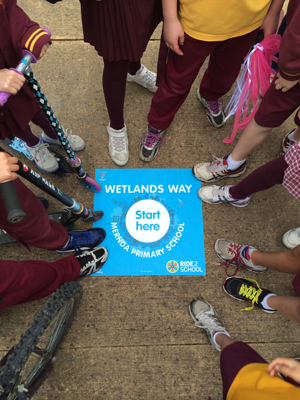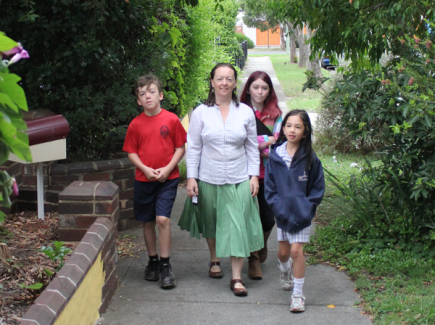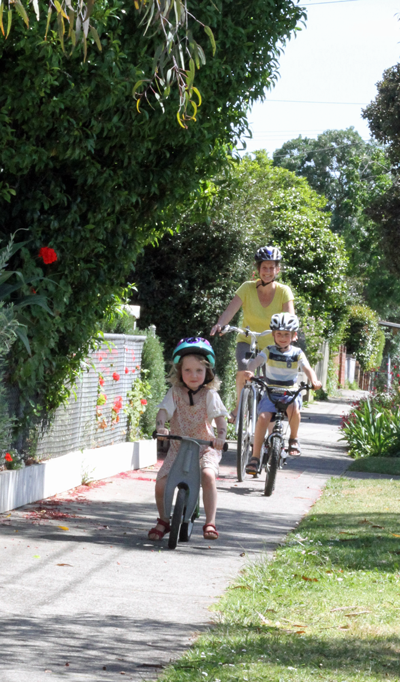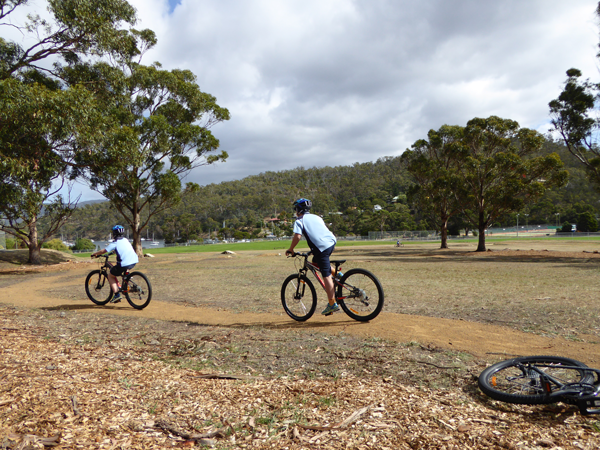Wheeling and walking to school brings more than physical health, it also builds resilience, providing kids with vital personal development that their studies in class can’t deliver. Simon Vincett investigates.
“Tomorrow we’ll all go to the island with you. See? The whole lot of us. Why shouldn’t we? Your mother said we could spend a week there anyway…We shall enjoy ourselves and have a marvellous time.” Five run away together Enid Blyton
Go Julian, George, Dick and Anne (and Timmy the dog)! Rather than endure the tyranny of a cruel housekeeper left to look after them, they escape to freedom. The independence and daring of the Famous Five are still inspiring children to adventure nearly 100 years after the first stories were published.
 Without mentioning the word once in 21 books about them, Enid Blyton’s characters epitomise resilience. Through one exciting situation after the next Blyton shows children being resourceful, coping and working together in a way that is enthralling for kids.
Without mentioning the word once in 21 books about them, Enid Blyton’s characters epitomise resilience. Through one exciting situation after the next Blyton shows children being resourceful, coping and working together in a way that is enthralling for kids.
Any parent can attest that kids hunger for challenges and excitement. Even the iPad is put aside for the chance to paddle their own canoe; an Xbox doesn’t deliver extreme thrills like scrambling over precipitous boulders; Minecraft just can’t bring the exhilaration of swooping through the bush on a mountain bike.
While adventure opportunities abound on holidays by the sea and camping in a National Park, there are plenty at home in everyday life as well. Kids’ rampant imaginations make any outing an adventure. Walking or wheeling to school, for instance, is never directly along the footpath by the shortest route but instead over as many bumps as possible and with myriad diversions to investigate the minutiae on display.
This drive to explore, engage with their world and to test their abilities is innate in kids. It’s the natural process of developing the physical, cognitive, social and emotional capacities that comprise their individual whole self. They’re on the journey to becoming independent capable beings in their own rights and the job of their community is to support them in this development.
However, signs are multiplying that Australian kids are not being allowed sufficient opportunity to learn independence and autonomy. A study commissioned by VicHealth and led by researchers from La Trobe University set out to identify the barriers to independent physical activity for kids.
The Beyond the bubble-wrap report from the research gives the overview: “Many people think that today’s parents are too worried about their children’s safety and aren’t giving their children opportunities for healthy growth and development. Commentators use terms such as ‘helicopter parenting’, ‘cotton-wool kids’ and ‘bubble-wrapping children’ to describe this situation. Overly fearful parenting has been suggested as contributing, among other things, to declining levels of independent physical activity in children and high rates of childhood obesity.”
A parliamentary report from the UK, Play, makes the same observation. It cautions of the negative effects of not allowing kids to be independently active: “Children who do not have the opportunity to control their own actions, to make and follow through on their own decisions, to solve their own problems, and to learn how to follow rules in the course of play, grow up feeling that they are not in control of their own lives and fate. They grow up feeling that they are dependent upon luck and on the goodwill and whims of others, a frightening feeling indeed when one realises that luck goes both ways and that others are not always dependable.”
What is on the line for our children is their capacity for resilience. Ride On asked lead author of the Beyond the bubble-wrap report, Dr Amanda Cooklin of La Trobe University, for a definition of this fabled quality. “Components of resilience are problem solving, knowing what to do in a crisis, feeling good and having a sense of competence. All of those things are supported for kids by gaining independence, learning to rely on themselves and how to manage in the world alone.”
While resilience was not specifically measured in the La Trobe research, it was through tracking the significance of the elements of resilience that brought the researchers to the conclusion that more must be done to provide autonomy to our children in how they get around.
“Independent mobility of any kind can really deliver a sense of confidence and self-esteem to kids, it can support them problem solve, it gives them a sense of responsibility,” explains Dr Cooklin.
This is a message enthusiastically taken up by Sarah Diamond, Manager of Bicycle Network’s Ride2School program.
“This is why we are so passionate about the Ride2School program,” says Diamond. “Because in addition to the physical health benefits, travelling actively brings so much more to kids.”
“Resilience is one of those buzz words. It’s a very desireable quality, which is why the word resilience appears in so many school mottos,” observes Diamond. “But it’s also an essential skill to build up in kids – we need to give them the opportunities to develop it.”
Being at the forefront of encouraging active travel to school, Diamond sees the barriers first hand: “The number one issue that prevents children from walking and riding to school is parental fear. This comes in two parts; concern about the dangers of traffic and ‘stranger danger’. Despite child abduction by strangers being a tiny minority of total abduction figures and at a very similar level to the 1970s, perception of the crime is higher.”
 Ride2School’s response to this is Active Paths. This tool establishes a network of routes to a school and clearly marks them out with decals on the footpaths. Sarah Diamond explains: “Active Paths have become something of a flagship initiative for us. It’s great for schools because it provides students with recommended travel routes that combine suitable infrastructure and popular existing routes, helping families to navigate their way to school if it is unfamiliar.
Ride2School’s response to this is Active Paths. This tool establishes a network of routes to a school and clearly marks them out with decals on the footpaths. Sarah Diamond explains: “Active Paths have become something of a flagship initiative for us. It’s great for schools because it provides students with recommended travel routes that combine suitable infrastructure and popular existing routes, helping families to navigate their way to school if it is unfamiliar.
“The start of each path is located at a point where there is parking available and is a community space. We encourage families who live that bit too far to walk or ride the whole way to use the paths to travel part way.
“The routes also build a sense of community and active travel as a social norm. If parents see more students out walking, they are more likely to allow their own child to walk or ride to school.”
This sense of community is key to success.
“It’s not about pushing parents to overcome these barriers,” Dr Cooklin explains. “It’s about providing environments and neighbourhoods and communities that support these parents.”
Parent Susan Rennie has experienced this first hand. Her three children now travel independently to school but it was a process for everyone to get used to it.
“Back when Anouk was in prep and Xavier was in grade one and Hannah was in grade three we were wondering about letting them do it,” Rennie explains. “We were a little bit nervous about the walk to school at first because it’s not around the corner – it is one and a half kilometres away – and also there are at least ten or twelve streets that they have to cross to get from our house to the school. So once or twice a week, we would walk to school with them.”
 The following year, Rennie found there were some slightly older kids around the corner whose parents were also interested in their kids travelling independently. The neighbour’s daughter from across the road was keen to join in too.
The following year, Rennie found there were some slightly older kids around the corner whose parents were also interested in their kids travelling independently. The neighbour’s daughter from across the road was keen to join in too.
“All of a sudden there were six kids. That felt like quite a different proposition to let six kids walk to school instead of just our three,” says Rennie. “Particularly because my kids are very small and they look a couple of years younger than they actually are. It felt like sending out these babies. So having these few extra kids made a difference.”
But the kids soon found that the group of six didn’t always work in terms of social dynamics between them.
“It worked to relieve our anxiety about sending them off by themselves,” laughs Rennie, “but within a couple of months it became clear that the girls didn’t like walking with the boys and that caused more problems than it solved. So then we said ‘Well go by yourselves’. The message I had was to look out for each other – you don’t have to be right next to each other. The reality was that the group could split out over 10 or 20 metres at times because everyone had a different pace and some people liked to dawdle.”
This social aspect is in fact a significant developmental benefit of independence, the La Trobe research found. In addition to discerning their own likes and dislikes, kids learn to consult and reflect in relation to their peers.
“The kids are really great at talking about how they loved being out and about with their friends,” says Dr Cooklin, “because they get to tell secrets and form good relationships and engage with their friends in a really positive way that may not be possible when an adult is present.”
Susan Rennie’s instinctive reaction to reach out to other parents in her neighbourhood is an ideal example of overcoming natural concerns.
The La Trobe research found that fear of disapproval from others proved a key factor stopping parents from allowing their kids to travel independently.
“Whether they thought they’d have disapproval from teachers, school principals and from family members, it was one of the main factors contributing to kid’s lack of independent travel,” attests Dr Cooklin. “It was really powerful, over and about the factors that we commonly think about – the bike lanes, the traffic, the fear of strangers.”
Rennie has seen community develop around her kids’ trip to school.
“Because my kids walk down a road where quite a lot of parents drive they became very visible and people would see them walking. I’d often have parents say to me ‘I reckon your kids were probably late this morning because I saw them dawdling on their way to school.’
“So I also had a sense that there was a community looking out for the kids. There was a sense that they don’t walk in a desert – there are a lot of people in the street, even if they’re in cars.
“I see a lot more children walking than when we first started. Most are smaller kids with parents walking or riding with their kids, which is part of the process.”
VicHealth has taken the next step with the La Trobe research and provided advice to parents and guardians of steps to take towards active transport and independence for their kids.
“There’s no absolute age and stage that’s appropriate,” stresses Dr Cooklin. “Absolutely correctly, parents are looking at their own environment, their neighbourhood, their level of comfort and what their kid’s capacity and responsibility is. Parents are making good judgements based on what they have to work with. For all families it happens differently at different stages.
“What we saw across primary schools from about the age of nine upwards some kids were starting to have some independence, but quite small steps: it might be around the corner to the deli or across the road to a friend’s house building up to some who were able to travel independently to school by the end of primary school.
“Then there seems to be this big jump. Most kids don’t go to their local high school. So they are needing to travel by public transport to get there. That really pushes the issue for families. Then it really doesn’t increase much from there. Where you are at 13 with independent travel is how it is for the next few years.” [Note: this study didn’t look at young people older than 15.]
Like most activities, it takes good modelling and much repetition to teach our kids to become competent in traffic, so the sooner you start the better. This is especially the case in the state of Victoria, where kids are required to ride on the road once they are 12 years old.
 Sarah Diamond knows the importance of parents delivering these lessons. “Children learn about the world around them through experience. By walking around their local area they learn how to navigate and be safe around traffic from their parents. It isn’t up to the school to sit children in the classroom and show them a video on how to be safe they need to learn and practice those skills regularly.”
Sarah Diamond knows the importance of parents delivering these lessons. “Children learn about the world around them through experience. By walking around their local area they learn how to navigate and be safe around traffic from their parents. It isn’t up to the school to sit children in the classroom and show them a video on how to be safe they need to learn and practice those skills regularly.”
Dr Cooklin concurs: “It is a transition for families. Kids don’t go from being dependent to being independent overnight. There are a series of steps that we probably all do quite intuitively: teaching them how to cross the road, and letting them do a little bit more and a little bit more and work up to those bigger steps towards independence.”
Susan Rennie sees important life lessons on offer from greater independence for kids.
“Even if they were dawdling and parents would tell me that they were likely to be late for school, well that’s part of childhood,” she explains. “Sometimes I drive them and they’re late for school too. It’s about them taking responsibility for being on time instead of it being someone else’s responsibility. I expect if they’re late they’ll experience whatever consequences the school chooses for lateness and that’s a natural lesson. Then they can pick up their pace if they don’t want to experience those consequences again.”
Rennie’s eldest is now 12 and has just started a new chapter of independent travel.
“Hannah has just started at high school and she’s getting on the tram by herself to school each day. She’s also taken the bus a couple of times, experimenting with which is the best way for her.
“We started in the holidays, with Hannah and her friends giving them Myki cards and a Darebin travel map and just saying go off and explore. Because once again that felt like a really safe thing to do with a bunch of four or five kids. So even though none of them had really done it, we just said see where you end up, and then come back again.
“They had fun. When you’re by yourselves and you don’t have a grown-up with you, getting tram down to Westgarth, having an ice-cream and catching a train back up to Thornbury can be a lot of fun.
“This will give her extraordinary independence. It was a big step from not having taken public transport a huge amount to being in the tram by herself.
“It felt like a big step to me.”
Independence and activity are all that matter to the folk at Ride2School.
“Whether it’s riding, walking, scooting or skateboarding, it’s all valuable independent physical activity,” says Sarah Diamond. “Walking to public transport is also valuable active travel and there’s also the option to drive part way and travel actively for the balance of the trip – part way is OK. Our key message is that the journey to school is an opportunity not to be missed for regular activity for kids, with all the physical, cognitive, emotional and social benefits that it brings.”
National Ride2School Day in 2017 is Friday 17 March, ride2school.com.au
Ride On content is editorially independent, but is supported financially by members of Bicycle Network. If you enjoy our articles and want to support the future publication of high-quality content, please consider helping out by becoming a member.

